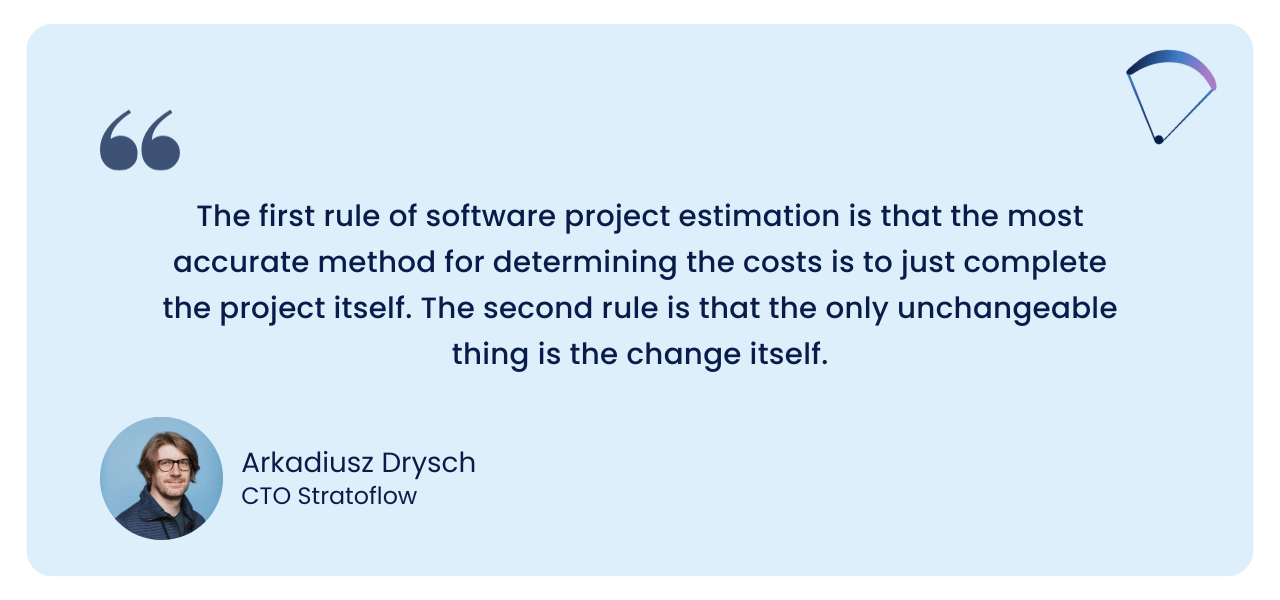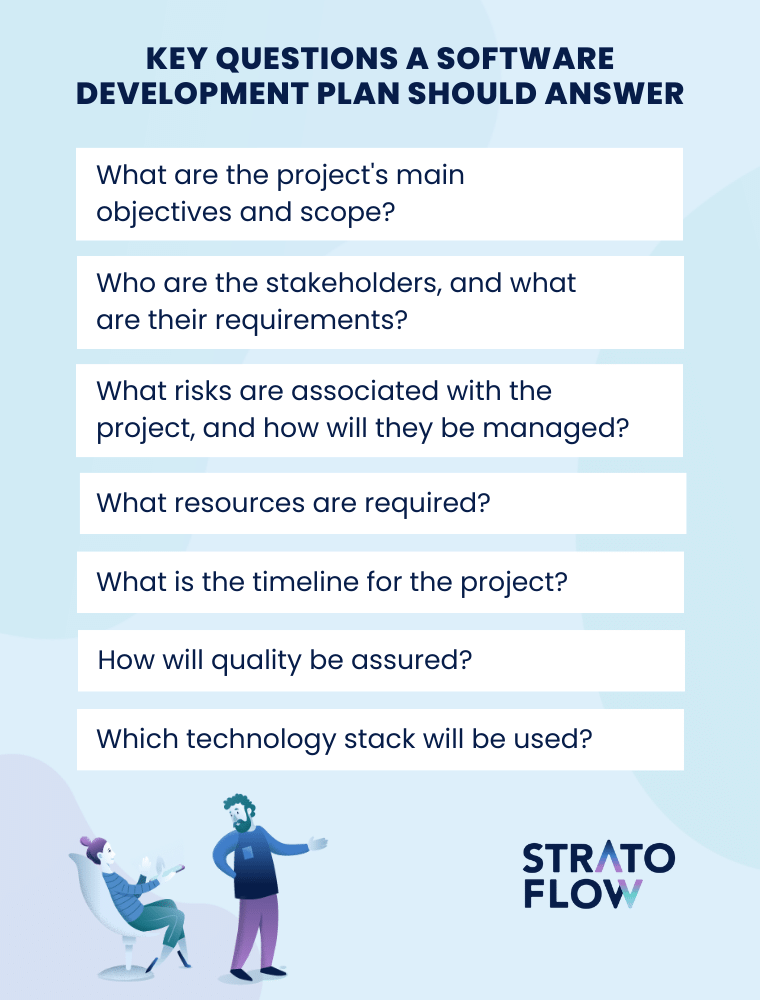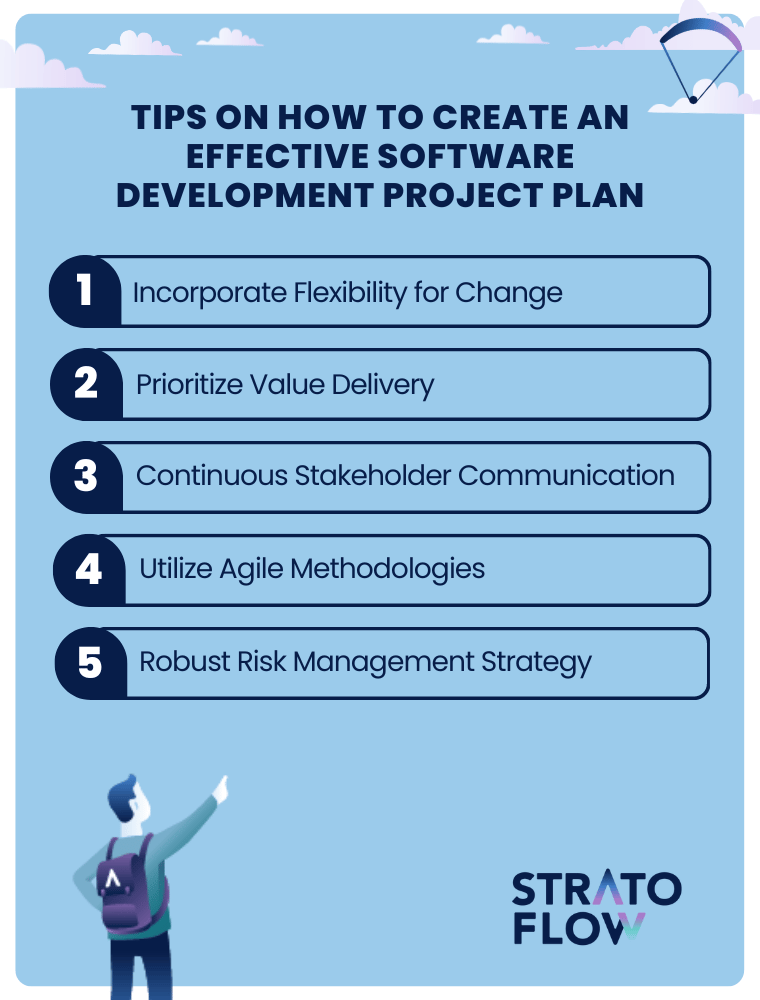
SDLC Guide: Software Development Planning Stage Explained
Did you know that on average, IT development projects run 45% over budget while delivering 56% less value than expected?
Is there a way to address these inefficiencies?
Yes, it’s in the form of solid software development planning.
In the second installment of our series on the SDLC, we are still in the first phase of the software development lifecycle – analysis and planning. We will explore the essential components of effective software development planning, from defining goals and scope to selecting the right technology stack and allocating resources. Since this is the foundation of any successful software development project, you don’t want to miss it!
Contents
- What is a software development project plan?
- Why is the software development project plan important?
- What are steps in software development plan?
- Key questions a software development plan should answer
- How to create an effective software development project plan? Expert tips
- The next step of the software development process
What is a software development project plan?
A software development project plan is a detailed outline that guides a team in creating software.
It’s like a map that shows the path from start to finish.
It details the steps involved in creating the software, specifying tasks, assigning them to team members, and setting deadlines for completion.
The plan also sets deadlines and decides how much money will be needed.
Essentially, the software project plan acts as a blueprint that outlines the software’s features, functions, and operational framework.

Why is the software development project plan important?
A software development project plan is important because it serves as a detailed guide for teams building software.
It organizes the software development process, breaks it down into manageable tasks, and assigns those tasks to specific team members so that everyone knows their responsibilities.
The plan sets clear deadlines, manages the budget, and outlines software features to ensure the project stays on track and meets user needs.
It keeps stakeholders informed and reduces risks by including contingency plans.
What are steps in software development plan?
Now it’s time to get down to brass tacks and start talking about how to plan out software development projects.
Below we’ve listed eight steps that we’ve found to be critical in this phase of the software development lifecycle that we’ve also put into practice on the projects that we’ve previously worked on:

Step 1: Define Objectives and Project Scope
Defining goals and scope is the first and very important step in creating a software development plan.
Simply put, this step is about setting clear goals and deciding what the software project will and won’t include. It’s like setting the destination and boundaries for a journey.
During this phase, you focus on understanding what the software needs to do. This involves talking to stakeholders – these could be customers, business managers, or anyone who has a vested interest in the software. The goal is to get a clear picture of their needs and expectations.
You also need to identify the problems that the software will solve. This helps to align the software’s features with the users’ needs. It’s like making a list of what the software should do to be useful to its users.
Another important aspect is defining the scope of the project. This means deciding what features and functionalities will be included in the software. It’s important to be realistic about what can be achieved within the given time and budget constraints.
Clear goals also help prevent “scope creep,” where the project grows larger than originally planned, often leading to delays and additional costs. Keeping the scope well defined and controlled is key to staying on track.
Step 2: Build a Great Development Team
The second step in creating a software development plan is to build the development team.
This step involves assembling a group of skilled professionals who will work on the software project. Think of it as assembling a sports team, where each player has a specific role that contributes to the team’s success.
Working with experienced professionals is critical.
Experienced team members bring a wealth of knowledge, skills, and insights from past projects. They can anticipate potential problems, offer innovative solutions, and ensure the quality of work that is essential throughout the entire software development process.
Key roles on a software development team typically include:
- Project Manager: This is the person responsible for project management. They oversee the project, ensuring it stays on track with timelines and budgets. They’re like the team captain, coordinating efforts and keeping everyone aligned with the project’s goals.
- Business Analyst: This person understands the business needs and translates them into technical requirements. They bridge the gap between stakeholders and the technical team.
- Software Developers/Engineers: They are the builders of the software, writing code and creating the functionalities outlined in the project plan.
- Quality Assurance Testers: Responsible for testing the software to find and fix any bugs or issues. Their work is crucial for ensuring the software is reliable and meets quality standards.
- UI/UX Designer: Focuses on the software’s design and user experience, ensuring it is user-friendly and appealing.
- Database Administrator (DBA): Manages the database, ensuring data is stored securely and efficiently.
- Technical Support/IT Specialist: Provides technical support and ensures all the IT infrastructure works smoothly.
Outsourcing software development projects to custom software development companies like Stratoflow can offer several advantages.
These companies offer larger organizations an invaluable pool of experienced professionals with expertise in areas such as e-commerce, fintech, and travel.
Outsourced developers also have established processes and methodologies that have been honed and tested in many real-world scenarios, which can lead to more efficient and effective project execution.
Step 3: Gather and Analyze Project Requirements
This phase is about gathering detailed information about what the software needs to do and how it should work.
It’s like making a shopping list before you start cooking a meal; you need to know exactly what ingredients you’ll need.
During this step, the team talks to stakeholders, end users, and customers to understand their needs and expectations.
This requirement analysis may involve interviews, surveys, or workshops. The goal is to gather as much relevant information as possible about what the software is expected to do.
During this phase, the team also estimates the time and cost of functionality, which is one of the most problematic aspects of the entire planning phase.
Arkadiusz Drysch, Stratoflow CTO, has rather jokingly said that:
“The first rule is that the most accurate estimation method is to just complete the project. The second rule is that the only unchangeable thing is the change itself.”

One thing is for sure – the more time spent analyzing and establishing preliminary assumptions, the more accurate the estimate will be.
Regarding software project estimation, here are three important rules:
Rule 1: Feasibility First, Estimation Second
Before jumping into estimating time and cost, it’s important to assess whether the project is feasible.
This means looking at whether the technical, financial, and time aspects of the project are achievable. Only when feasibility is confirmed should the team move on to detailed estimates.
Rule 2: Extrapolation is the Way to Go
Any development project can be broken down into smaller, more manageable tasks that generally have a comparable level of difficulty.
A smart approach to estimating the time and effort required for a software development project is to use extrapolation. This method involves selecting a handful of tasks that are typical in terms of difficulty, estimating the time and effort required to complete them, and then applying that estimate to the total number of similar tasks in the project.
Rule 3: Preliminary Assumptions Should Be the Foundation of the Project
Early in the project, certain assumptions must be made about things like user needs, market trends, and technological capabilities.
These assumptions form the basis of the project plan. However, it’s important to periodically review and adjust these assumptions as more information becomes available.
[Read also: Off the Shelf vs Custom Software: Pros & Cons + Examples]
Step 4: Define Your Project Workflow
In this phase, the team decides which software development methodology to use. This could be Agile, Waterfall, Scrum, or any other methodology that fits the needs of the project and the way the team works.
The choice of methodology is critical because it determines how tasks are organized, managed, and executed.
It’s like choosing between a scenic route or the fastest highway; each has its advantages and is appropriate for different situations.
An agile methodology, for example, allows for more flexibility and regular adjustments based on continuous feedback. It’s like planning a road trip with the flexibility to change the route along the way.
Step 5: Conduct Feasibility Study and Risk Assessment
Evaluate the feasibility of the project in terms of technical capability, budget, time constraints, and other resources.
During this phase, the team examines various aspects:
- Technical Feasibility: Assessing if the technology needed for the project is available and adequate.
- Economic Feasibility: This aspect is about determining if the project is financially viable, considering the budget and expected return on investment – many companies underestimate the cost of robust custom projects.
- Legal Feasibility: Understanding legal and compliance issues related to the project.
- Operational Feasibility: At last comes the evaluating if the project can be integrated into current operations or if new processes need to be developed.
Developing a Proof of Concept (POC) and a Minimum Viable Product (MVP) are important parts of this phase:
- POC (Proof of Concept): This is a small exercise to test the technical feasibility of the idea. It’s like taking a short test drive to see if your plan is doable.
- MVP (Minimum Viable Product): This involves creating a basic version of the software with enough features to satisfy early users and provide feedback for future development.
Step 6: Choose the Right Tech Stack
Choosing the right tech stack is a critical step in software development, similar to choosing the right set of tools and equipment for building a house.
A tech stack is the combination of technologies that an organization uses to build a web or mobile application. It includes everything from programming languages to frameworks and tools used in the application development process.
The tech stack is typically divided into two main components: the front-end (or client-side) and the back-end (or server-side).

Front End
This is what users interact with. It includes everything related to the user interface and user experience. Key elements are:
- HTML/CSS: Used for creating and styling web pages.
- JavaScript: A programming language that adds interactivity to websites.
- Front-end Frameworks: Tools like React, Angular, or Vue.js that provide ready-to-use components for building user interfaces.
Back End
This is the server side, where the application’s logic, database interactions, and user authentication are handled. Key elements are:
- Programming Languages: Such as Python, Ruby, or Java, used to write server-side logic.
- Frameworks: Tools like Django (Python), Ruby on Rails (Ruby), or Spring (Java) that offer structures during web application development process.
- Database Management Systems: Such as MySQL, PostgreSQL, or MongoDB, used to store and manage data.
DevOps Tools
These are tools used for automating the deployment and operation of applications, like Docker for containerization or Jenkins for continuous integration and delivery.
Rapid software development tools
In addition to these classic development approaches and tech stacks, there’s an alternative in the form of open-source development platforms, such as Openkoda.

Platforms like Openkoda or Odoo reduce the amount of traditional hand coding, enabling faster delivery of applications.
They offer pre-built templates and functionalities that make it easier for developers to create applications. This approach can be particularly useful for organizations that want to develop internatl management applications without investing heavily in a full-stack development process, making it a cost-effective and time-efficient solution.
Step 7: Allocate Roles and Responsibilities
Staying with our construction process metaphor, assigning roles and responsibilities in a software development project is like assigning tasks in the construction of a house.
Just as in the construction of a house, where you have architects, electricians, plumbers, and carpenters all doing their part, in software development each team member is assigned a role that matches their skills and the needs of the project.
In this step, the project manager or team leader assigns specific roles and tasks to team members based on their skills, experience, and the needs of the project. This assignment is critical to ensuring that each aspect of the software development process is covered by someone with the right expertise.
By clearly defining these roles and responsibilities, each team member knows exactly what is expected of them, which helps to avoid confusion and overlapping tasks. It ensures a more organized and efficient workflow, where everyone contributes their expertise towards the common goal of developing a successful software product. This step is fundamental to building a cohesive and effective team, which is critical to the smooth execution and success of the software development project.
Step 8: Establish a Communication Plan
Establishing a communication plan is an essential step in software development, ensuring that there is a clear, continuous, and effective exchange of information between the development team and stakeholders.
Effective communication is key to project success because it ensures that everyone is on the same page regarding the project’s goals, progress, and any issues that arise. It facilitates transparency, allowing stakeholders to stay informed and involved in the project’s progress.
A variety of tools and platforms can be used to establish clear and robust communication links between team members and stakeholders:
- Email: For formal communications, updates, and documentation.
- Instant Messaging Tools: Platforms like Slack or Microsoft Teams allow for real-time, informal communication and quick collaboration.
- Video Conferencing Tools: Zoom, Google Meet, or Microsoft Teams for virtual meetings, especially useful for remote teams.
- Project Management Software Tools: Applications like Trello, Asana, or Jira offer integrated communication features and allow for tracking project progress and tasks.
- Document Sharing Platforms: Google Drive or Dropbox for sharing and collaborating on documents.
- Feedback Tools: Tools like SurveyMonkey or Google Forms for collecting structured feedback from stakeholders.
It’s pretty self-explanatory, but when used effectively, these tools can bridge the communication gap between developers and stakeholders, ensuring that everyone is informed, aligned, and engaged throughout the project.
[Read also: Your Essential Guide to Nearshore Software Development]
Key questions a software development plan should answer
Creating a solid and thorough software development plan is a fundamental aspect of project management that lays the foundation for a successful project outcome.
A well-structured plan ensures that all team members are aligned on project goals, timelines, and deliverables, thereby increasing efficiency and reducing the likelihood of project delays or budget overruns.
It serves as a roadmap that guides the team through each phase of development while providing a clear framework for decision-making and problem-solving.

What are the project’s main objectives and scope?
- What is the project aiming to achieve?
- Why are we completing the project?
- What features and functionalities will the software include?
- What will the project be expected to deliver?
Who are the stakeholders, and what are their requirements?
- Who will use the software, and what are their needs?
- Who will be involved in the software project?
- How will the software address these needs?
What is the timeline for the project?
- When is the project required to be delivered?
- What are the key milestones and deadlines?
- How are tasks and phases scheduled throughout the project?
What resources are required?
- What budget is allocated for the project?
- What human and technical resources are needed?
Which technology stack will be used?
- What programming languages, frameworks, and tools will be employed?
How will quality be assured?
- What testing strategies will be implemented?
- How will the quality of the software be measured and maintained?
What risks are associated with the project, and how will they be managed?
- What potential challenges could impact the project?
- What strategies are in place for risk mitigation?
How to create an effective software development project plan? Expert tips
Based on extensive experience in completing numerous software development projects, here are five insightful tips from our most experienced programmers and project managers for creating an effective software development project plan:

Incorporate Flexibility for Change
While it’s important to have a structured plan, software development often involves unforeseen changes, whether in technology, market demands, or customer requirements.
Build in flexibility by planning for regular iterations and reviews.
This approach allows adjustments to be made in response to feedback or new information, ensuring that the project remains relevant and on track.
Prioritize Requirements Based on Value Delivery
Not all features in a software project are equally important. Prioritize requirements based on the value they provide to the end user.
Use techniques such as MoSCoW (Must have, Should have, Could have, Won’t have this time) to categorize and prioritize features. This ensures that the team focuses on delivering the features that will have the greatest impact, improving the overall effectiveness of the project.
Engage in Continuous Stakeholder Communication
Regular and clear communication with stakeholders is essential.
Develop a communication plan that outlines how and when updates will be provided. This will keep stakeholders informed and involved, and reduce the risk of misunderstandings or mismatched expectations. Regular stakeholder engagement also provides valuable feedback that can be used to refine the project plan.
Utilize Agile Methodologies Where Appropriate
Agile methodologies, such as Scrum or Kanban, provide a flexible and iterative approach to software development.
They enable the team to adapt quickly to change, deliver work in manageable increments, and continuously improve processes. This approach can increase team productivity and responsiveness to change, leading to a more successful project outcome.
Implement a Robust Risk Management Strategy
Identify potential risks early in the project and develop strategies to mitigate them. This should include regular risk assessments and updates to the risk management plan. By proactively managing risks, you can minimize their impact on the project, ensuring smoother execution and a higher likelihood of success.
The next step of the software development process
Following the planning phase in the Software Development Life Cycle (SDLC), there are several key phases. The first is the “design” phase, where the system and software design is prepared based on the requirements gathered.
This leads to the Development phase, where the actual software is developed. This is followed by the ‘Test’ phase, which ensures that the software is bug-free and meets the specified requirements.
Once tested, the software enters the “Deployment” phase, where it is released and made available to users. Finally, the “Maintenance” phase involves making the necessary changes, corrections, updates, and improvements to ensure that the software continues to function smoothly.
Conclusion
We hope this guide has provided an in-depth exploration of the planning phase – a critical part of the Software Development Life Cycle (SDLC).
By emphasizing the importance of thorough planning, from defining goals to allocating resources, this guide provides professionals with the knowledge to lay the foundation for successful software development.
Understanding and meticulously executing this phase sets a clear path for the subsequent phases of the SDLC, ultimately leading to the efficient and effective creation of software solutions.
Related Posts
- How to Build an Inventory Management System: Key Steps and Tips
- How to Build a Document Management System: Alternative Approach
- Online Shopping Recommendations – Introducing Them to Your Business
- Amazon Product Recommendation System: How Does Amazon Algorithm Work?
- Movie Recommendation Systems: A Business Guide
Thank you for taking the time to read our blog post!
